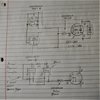For the most part I don't use a gate resistor as it can restrict the rise time. Just get the totem pole as close to the gate as you physically can.
Because the gate source junction is quite capacitive, the input current to the gate is determined by the signal rise time and can be quite high.
The sum is: I= C*dv/dt. (That's from memory, hope I got it right)
Where C is in Farads
dv is the amplitude of the voltage transition.
dt is rise time in seconds.
The high end frequency will depend on the current gain vs frequency of the BJT's. and will be defined as its transition frequency. That can be determined from their data sheet. You will also need to consider their turn on and turn off times plus the time it takes for the device to respond to the signal as this will directly affect the maximum frequency you can expect.
With the exception of current gain, the same is also true for the FET.
Also bear in mind that if you are looking for a square wave output and you try to run at max possible F' then the signal will look more like a triangle. All these factors will also affect power dissipation in the output device.





